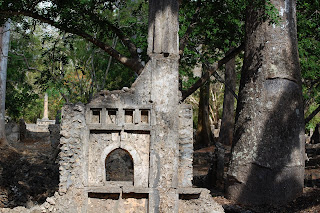
After most of our company from the US departed last week, E and I decided that we needed a little getaway… from our getaway. Seriously though, the last few weeks have been pretty stressful while we’ve been trying to figure out a lab-related plan of attack for the last few months of our stay. Plus your pipette muscles get sore after the 20,000th aliquot of the day so we just felt the need to get away from the house for a few days.
We settled on Malindi, a town about three hours north of Mombasa (the 'North Coast'), which has in recent years become somewhat of a hub for Italians. More on that later.
Some friends of ours in town helped us find a very cheap car rental place in Diani, and we headed up the coast on Saturday morning. Crossing the ferry was thankfully uneventful, and before too long, we were on the open road heading north. Our first planned stop was the ruins of an ancient Swahili town called Gede.
Gede was built in the 14th century by a Swahili tribe, and was quite prosperous for hundreds of years. The Swahili are a coastal tribe with territories from Somalia to Tanzania and were often the middle-men between Arab traders and inland African tribes. They converted to Islam through their interaction with the other traders and were among the wealthiest Africans because they controlled access to foreign goods. The influence of the Swahili culture has since diminished and several signs in Gede referred to the “Golden Age of Swahili Culture” as the 15th century. Gede, therefore, was built in this heyday.
By the 17th century, Gede was abandoned, either because of neighboring marauding tribes, or because the water table inexplicably dropped and the wells dried up. Regardless, the town was lost until the late 1800s, at which point it was lost again until about 1930. Very forgetful, those Kenyans.
During excavations of the site, archeologists uncovered a sophisticated, prosperous city. Fine china, Chinese money, Venetian glass, Spanish scissors, Indian iron lamps, and other items were found, indicating an expansive trade network through the Indian Ocean. The site has since been designated a national park and is protected from logging and such. Most of the remaining city is constructed from coral blocks; there was a large surrounding city that housed the lower and middle class, but their dwellings rotted away long ago.
E and I arrived and decided that for this kind of site, a guide would add a lot to the experience, so we found little Alphus, who proved to be as good of a guide as he was tiny. See below.

Here’s me in the main mosque (there are nine in the town):

We learned that the mosque was partitioned so that women sat on one side of the wall and men, including the iman, sat on the other. In order that the women could hear the main prayers, the Swahilis fashioned these echo chambers (that's the little alcove I'm standing in above).
The iman could recite into a small hole in the wall and his voice was amplified throughout the mosque. I made a small attempt with a very American “hello” before Alphus shoved me aside and performed a haunting call to prayer as we stood in the forest mosque. It was quite surreal.
A “pillar tomb”, unique to the Swahili Muslims:

The buildings are all named very descriptively: “The House of Scissors”, “The House of Chinese Money”, “The House of Cowries”, etc. based on where they found various artifacts. Since there is no written record of the town of Gede, they can only go by what they find in their excavations.
Here is a water channel where the townspeople bathed before entering mosques. The city was designed with water in mind with bathrubs and latrines so you can see the issues if the water suddenly dried up:

A short diversion, but an interesting one, nonetheless. Though there’s a ton of history in Kenya, being the Cradle of Mankind and whatnot, there’s not a lot of old architecture. Most settlements, even today, are made with materials that don’t hold up well to the elements. Clay, wood, and palm fronds comprise the vast majority of construction in Kenyan villages. Coral blocks are used by the rich and for the more important structures like mosques, so I guess that mosques are the Kenyan equivalent of the cathedrals in Europe.
It’s still before noon on Saturday! Stay tuned for the rest of the story.
Also, congrats to all of my med school classmates who found out that they matched yesterday! We wish that we were there to celebrate with you. Now that you have a job and more free time, come visit!
What a great side trip, and I loved hearing of the history. I never would have thought of the longevity of the building materials, so it made sense when you mention the impermanent nature of the ruins. I loved the photo of you in the mosque-ette.
ReplyDeleteEnjoy this latter time in your trip, because soon enough you will be back to a society that will provide you with immense reverse culture shock. Keep those aliquot muscles strong!
Much love,
Linda/Mom